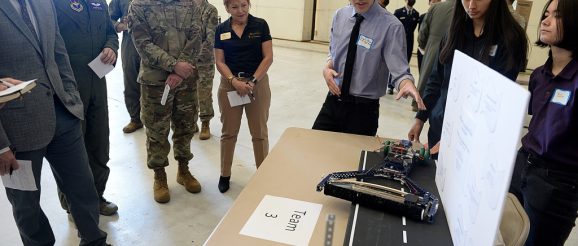Travis Spark Challenge returns, ignites innovation

At Travis Air Force Base, airmen are frequently coming up with ways to improve the base’s goal of defense readiness, especially amid a constantly changing world.
So too are high schoolers, who also come up with innovative solutions in the classes they take. It only makes sense that the two would come together for the base’s annual Travis Spark Challenge.
Formerly called the Phoenix Spark Challenge, this is the first time in three years the challenge has taken place at Travis, as it was postponed due to restrictions stemming from the COVID-19 pandemic.
Kelley Birch, director of college and career readiness at Solano County Office of Education, said the challenge is a partnership between Travis’ Phoenix and Nexus spark labs.
“Those are innovation labs here on the base that work to solve issues on the base: anything from problems on the airplanes to problems in an office,” she said. “They’re just trying to think creatively, outside of the box to solve issues, save money, save lives.”
Coordinator Sgt. Emily Overcast said the base coordinated with Birch and SCOE leaders, assigned problems for teams of high schoolers to solve and also had base mentors available to answer questions.
“Being here, actually getting to meet the students for the first time, is absolutely amazing,” she said.
This year, two teams participated from Will C. Wood High School and three from De Anza High School in Richmond. The challenges the teams had to address were fuel savings, designing a viable alternative to the foreign object damage (FOD) to prevent damage to flight line vehicles and creating an application that utilizes flow control around the red line perimeter, which non-authorized personnel are forbidden to cross, near the flight line.
For the fuel savings challenge, a team of automotive students at Will C. Wood — consisting of seniors Hayden Hawkins, Korbin Hope, Scott Rawlins and Luscious Simi — devised a plan to decrease diesel usage.
“They (the Air Force) use a lot of diesel — from my research, anywhere around 100 million gallons which is an insane number,” Scott said.
The group’s idea was to convert to electric mechanisms.
“We have electric options from small to large,” Scott said. Same output, and they last on average twice as long.”
Korbin said it would be a cost-effective way to save over time, and Luciouse said it would reduce the Air Force’s carbon footprint.
“There’s a lot of stuff going into the air that shouldn’t be going into the air,” he said. “This would reduce a huge amount of it, and it would really do a lot of good over time.”
Automotive technology teacher Chip Reeves said he worked with students to come up with a practical idea.
“SFO is already starting to use things like this, so why wouldn’t we bring it to the military also?” he said. “They took some of those ideas and ran with them, got more information, put their spin on (it).”
Reeves was proud of the work they did.
“I think young minds are a good thing,” he said.
Another Will C. Wood team — consisting of robotics and aviation students Cody Evans, sophomore; Rogelio Meza, senior; Alison Schonauer, senior; and Melissa Schonauer, freshman — tried to solve the issue of FODs getting on the runway and disrupting flights. Currently, Rogelio said cleaning it up is done manually when a plane is preparing to take off. His team’s plan was a device with a pressure plate that automatically turns on a conveyor belt with brushes to clean up debris and dirt before planes land on the runway.
“The idea is that we keep it clean by preventing anything from getting on the runway first,” Rogelio said.
The team began working on a concept for the challenge and started building the project a few months ago. Alison liked the collaborative aspect of it.
“I love the ideas and bouncing them off to see which idea we go with and merging them together and figuring out something that will work,” she said.
The teams got to show off their projects Friday just ahead of the weekend’s air show, with judges including Lisette Estrella-Henderson, Solano superintendent of schools; Col. Corey Simmons, commander of the 60th Air Mobility Wing; and airman Paul Nobisch, who was part of a team of Armijo High School students who won in 2018. Students had booths set up and prepared to answer questions of anyone who came by.
Birch said it was a great experience for students, some of whom had never been on the base before.
“These young people have some creative ideas and a different way of looking at things,” she said.
Overcash said the issues presented to the students go beyond the Air Force and can be applied to life itself.
“They had to put a lot of time, effort and energy into these projects,” she said. “That’s the same effort and energy that they can take later on into life and apply it to life situations.”
The winners were Wood’s aviation team for the FOD walk challenge, De Anza for the red line challenge, Wood’s auto team for the fuel savings challenge, and Wood’s aviation team won first place overall. The winners all received 3-D trophies printed at the Phoenix Spark Lab.
